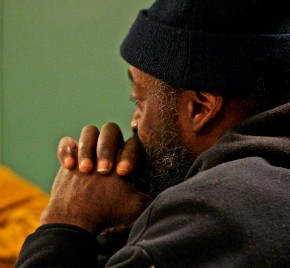The power of being with: Jesus model for ministry
Imagine you’re walking through a big city and you see a homeless person.
You have four options. The first is to say: we need to get people off the streets into housing, employment, and a profitable use of time. You may be energized to join the board of a night shelter or a day center assisting homeless people. You may be more direct and immediate and bring the homeless person in question a drink or a sandwich, an item of clothing, or a leaflet advertising various services. You may even be motivated to advocate for this person and others in similar circumstances by lobbying your political representative or organizing a meeting to address homelessness in the city.
The second option is to speak to the homeless person, to explore with them the reasons why they’re homeless, to ensure they know what options are available for them—the local drug and alcohol rehabilitation schemes, the places where free health care is available, the drop-in centers where there’s training and career advice, the places where there are art and singing and athletic groups to help build confidence and make connections. You may even offer to take them to these places.
Read our latest issue or browse back issues.
The third option is simply to sit down beside the homeless person and be with them, pass the time of day with them—share first names, talk about where they’re from, ask what it’s like to spend a day or a night outside, wonder what they think of people like yourself scurrying by, inquire if they feel frightened or lonely, drink a cup of coffee with them, discuss the latest developments in politics or athletics, and gradually locate the questions they really want to ask and the wisdom they have to share.
The fourth option is to feel rising anger about the fact that there are so many homeless people in the city and to denounce this situation on your blog, to become exercised about the use of the term “the homeless” instead of “homeless people,” to give money to appeals for organizations that work with homeless issues, and to ensure that no one makes any assumptions about mental health or a history of being abused or substance addiction when they meet a homeless person.
I’m going to call the first option working for, because when you go on boards and lobby politicians you’re working for the homeless person. And the second approach is working with, because it’s got all the energy of the first option but this time you’re actually engaging the homeless person in their own redemption, rather than deciding for them. The third approach, where you simply sit beside the homeless person for a coffee and a chat, is being with. And the fourth option is being for, because you don’t actually encounter the homeless person at all, but you orient your life for their well-being as you perceive it. You can imagine these four models—working for, working with, being with, and being for—as four quarters of an old-fashioned windowpane.
Working for is the default setting for most engagements with poverty. The homeless person is regarded as a problem and as a symptom of a deeper problem; the working for approach seeks to fix that problem with the range of resources that the professional person has. To someone with a hammer in his pocket, everything looks like a nail; likewise, the professional person sees the problems that his or her skills are equipped to solve. Being for is somewhat similar, except that it tends to assume the problem is someone else’s to address and adopts a position that’s more in solidarity with the homeless person or at least with homelessness in general. But note what working for and being for have in common: the little word for. Neither working for nor being for requires you to have any significant kind of conversation or interaction with a homeless person.
The idea that the homeless person may have a role in their own redemption isn’t considered. The result is that these models generate a host of solutions, but the solutions tend to get little or no response from the people they’re designed to help. Why are people so ungrateful? Most likely because if almost every interaction in their lives is one in which they are the client and source of distress, while the other person is the benefactor and source of salvation, the homeless person is not going to be inviting encounters that reinforce such humiliation. The experience of being a problem solver can be electric; the sense of being a problem to be solved is discouraging.
Consider the other two models, working with and being with. Both presuppose genuine, serious, and sustained interaction with the homeless person. Such interaction can be demanding, time-consuming, and lacking in excitement. The word with indicates that both models take for granted that the homeless person must be at the heart of whatever takes place; that there can be no transformation without agency. Working with seeks to attract a whole range of stakeholders and sees the homeless person as having a crucial contribution alongside service providers and concerned organizations. It’s a much more dynamic model than working for—and sensitive to a much wider range of contributions than simply professional expertise. Where working with differs from being with, however, is that working with still sees a problem—even if it’s a problem that’s shared by a range of different people and organizations. Think of community organizing, where the whole dynamic is to focus on a problem, isolate it, polarize in relation to it, and then bring together a coalition of stakeholders to address it. The whole process depends on the energy released and momentum gained in problem solving.
Being with, by contrast, doesn’t start with a problem—or if it does, the problem lies with you rather than with the homeless person. You don’t sit and have a coffee with a homeless person because you’re trying to solve their problem—you do so because you want to receive the wealth of wisdom, humanity, and grace that God has to give you through them. You aren’t the source of their salvation: they are the source of yours. If you talk about their problems, you make sure you’re attending to the ones they name and identify, rather than ones you perceive or imagine. Your every effort is to enjoy their being, and share your own, rather than change their reality assuming a script you’ve imposed from elsewhere.
Let’s recast this configuration in theological perspective. Does God see the world as a problem to be solved or a gift to be enjoyed? Does Christ become incarnate because there’s a job of redemption to be done and only he can do it, or because the whole point of creation was that God would dwell with us terrestrially in Jesus and eternally in heaven? How do we seek an answer to such a question?
I suggest the place to look for such an answer is in the shape of Jesus’ life. The incarnation presupposes that it was not enough for God simply to be for us. God is always for us, but that’s an inadequate way of understanding God’s purpose in making us and the world. God’s purpose is to be with us. For a week in Jerusalem, for moments in Galilee that we call miracles, in teaching and in challenging religious authority, Jesus was working for us. There’s a difference between creator and creatures: there are some things, most obviously creation, resurrection, and inaugurating and fulfilling the kingdom, that only God can do. But the Gospels don’t show us a God who in Christ is merely for us. They show us a Christ who is fundamentally with us. Jesus works with the disciples in Galilee—he employs them, trains them, empowers them, sends them, chastises them. However frail and foolish they turn out to be, there’s no question of him going to Jerusalem on his own. Yet we’re so familiar with the notion of Jesus teaching his disciples that we seldom ask ourselves if delivering us from our sins was all Jesus came to do, and if calling disciples was superfluous. There’s a job for the disciples to do, but that job is distinctively collaborative—it is, by definition, working with Jesus.
But the ministerial period of calling, training, and sending disciples, the working-with part, and the atoning process of passion, death, and resurrection, the working-for part, only make up perhaps 10 percent of Jesus’ life among us. What is the theological significance of the hidden 90 percent—the 30-odd years Jesus spent in Nazareth? Surely those Nazareth years demonstrate, in their obscurity as much as in their sheer duration, that God’s fundamental purpose is to be with us—not primarily to rescue us, or even empower us, but to be with us, to share our existence, to enjoy our hopes and fears, our delights and griefs, our triumphs and disasters. This is the way incarnation echoes creation and anticipates heaven: Jesus relishes life with us and bewilders and disarms us with his patience, his gentleness, his presence, and his attention. All the other actions of God are ways of preparing and redeeming the ground for the fundamental purpose of creation, salvation, and final redemption: God being with us. That’s all that was ever in God’s heart, and all that ever shall be.
Let’s reflect on our efforts at social engagement in the light of this exploration of God’s engagement with us. It’s easy to default to the working-for model. We fear quietism and cynicism and passive disengagement, associating these with the priest and the Levite who walked by on the other side. We want to believe in solutions, we want to think problems can be fixed, we celebrate the social reformers and philanthropists who righted the wrongs of the early industrial era. So we like the idea of working for, particularly when it highlights and harnesses our own skills. And working for is usually a good deal better than being for. Being for may vote, being for may write op-eds, being for may donate money, being for may compile research; but while assuming something must be done, being for generally assumes that it’s someone else’s job to do it. Working for at least assumes that we ourselves must be part of the doing. But in working for we seldom know the homeless person by name and almost never regard them as our teacher, and to that degree, it’s a model that ensures that the homeless person will remain a stranger to us. At best it can only be a means to an end.
Working with is closer to God’s ways with the world. There’s a great deal to be said for making partnerships with a range of stakeholders and inspiring the homeless person themselves to work on a project together. This surely is an image of the kingdom, where needy and powerful, expert and volunteer, faithful member of another faith and unbeliever can discover solutions and uncover deeper layers of obstruction together. This is Galilee. Poverty becomes a disease to be healed rather than a mechanism to be recalibrated, and all hands are needed to assault the disease. Working with offers more than a glimpse of God’s purposes for us and is a profound analogy for the dynamics of church. But it still presupposes an adversarial contest of defeating and overcoming, it still speaks the language of problem and solution, and it still assumes an occasionalistic picking-off of challenges one by one.
The goal of all our social engagement must surely be being with. Our faith is that God originally made, and endlessly reiterated, a decision never to be except to be with us. And our way of embodying that faith is constantly to look for ways to be with God, with one another, and with the creation. The goal of all our working for and working with isn’t independent, free-standing individuals, released from all setbacks and problems and challenges, but an interactive and permeable community of interdependent beings who discover gifts where others might only see needs and unearth treasure where others might only see trouble. Just as at the center of our common life is worship, the simple being with God for no purpose other than the glory and goodness of being so, so at the center of our mission should be being with the stranger, with the expectation of meeting and learning from and wondering at and enjoying the Christ made known in them.
Not long ago I went to visit an agency that works with homeless people. I explained to the director that I admired her work. I feared, I said, that at St. Martin’s we sometimes get so caught up with being professional, with service delivery, with providing options to homeless people, that we seldom take the time to sit down and be with such people. At this agency, I said, I could see that there was a lot more lingering over coffee and just hanging out. The director invited me to stay for lunch. When she was waylaid by people wanting to talk to her, I went into the dining room and sat with the first person I saw.
He was from Togo. He told me about his asylum claim. He shared with me his worries and his loneliness. He said how much it meant just to come to this place and be for a moment without fear or foe. And then something special happened. I asked him his name. He said, “I am Naz.” Naz. The man from Nazareth. Nazareth, the town where Jesus showed us God’s ultimate and fundamental purpose to be with us, now and forever. Naz. Looking me in the face. This was an angel, come to show me the purpose of my whole ministry: to be with God, as Jesus was with us in Nazareth, and to be with one another, forever.
This article is adapted from Wells's book A Nazareth Manifesto: Being with God, coming
from Wiley-Blackwell this month.







